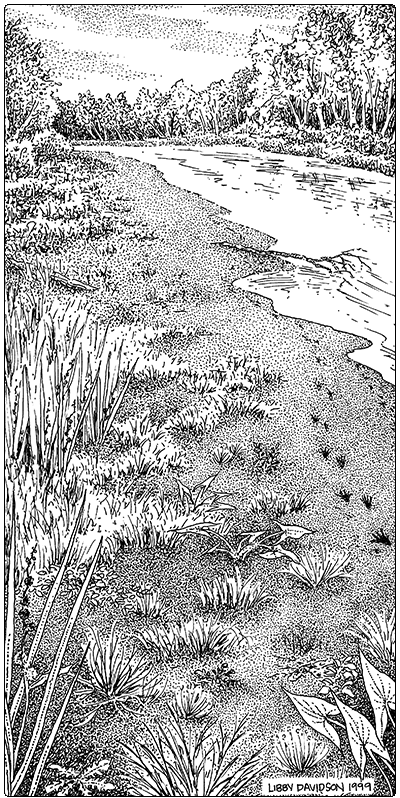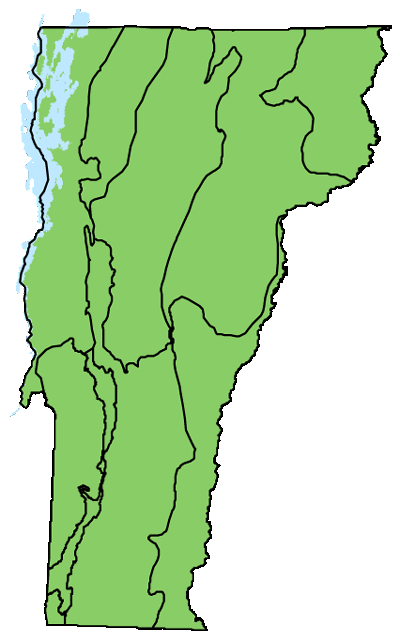Ecology and Physical Setting 
River Mud Shores are common along many of Vermont’s rivers but are typically very narrow. They occur primarily along the margins of our larger rivers where currents are slow, but they may also be found in sheltered coves, eddies, and backwaters of more high-energy rivers. The substrate is a muddy mix of fine mineral and organic deposits that are exposed only when river levels go down in the summer. Some of this fine, organic-rich substrate may be washed downstream during storms, but new deposits are laid down annually as water levels recede. In some years, River Mud Shores may flood intermittently throughout the growing season.
River Mud Shores commonly occur below Rivershore Grasslands and may also occur in sheltered areas of shoreline associated with River Sand or Gravel Shores.
Vegetation
River Mud Shores may be inundated until early summer. When the shoreline is exposed, the bare, sun-warmed mud is an ideal habitat for germination of seeds that have persisted in the soil for years or have been recently deposited on the soil surface. These conditions favor the life cycle of annual plants, which tend to dominate this very sparsely vegetated community. Typical plants include species of spikerush, Cyperus, and bulrush, as well as false pimpernel, rice cutgrass, and common monkey-flower. Quillworts may be present at the lower edges of these shores. Non-native invasive species may be common, especially at the upper edges.
Wildlife Habitat
Raccoon tracks are commonly found in the soft mud of this shoreline community. Great blue herons and spotted sandpipers are frequently seen hunting along the river edge. The herons prey on frogs and small fish, and the sandpipers feed on insects, snails, and worms. Green frogs may be frequent. Common shore tiger beetle and twelve-spotted tiger beetle both use a variety of shoreline communities, including these muddy shores. Blue-fronted dancer (a damselfly) and arrow clubtail (a dragonfly) are uncommon species in Vermont and are associated with muddy river shores, where their larvae burrow in the moist substrate.
Related Communities
- River Sand or Gravel Shores occur along river shores with faster moving water. They are also sparsely vegetated with graminoids and forbs.
Conservation Status and Management Considerations
River Mud Shores can be greatly affected by the operation of dams, which alter natural river flow regimes and sediment deposition. The rich, muddy, exposed substrate of this natural community is an ideal habitat for invasion by non-native plants.
Distribution/Abundance
River Mud Shores are found throughout Vermont on slow-moving sections of rivers. Similar communities occur across eastern
North America.
Characteristic Plants
Herbs
Occasional to Locally Abundant Species
Slender beakrush – Eleocharis tenuis
Needle spikerush – Eleocharis acicularis
Straw-colored flatsedge – Cyperus strigosus
False pimpernel – Lindernia dubia
Rice cutgrass – Leersia oryzoides
Common monkey-flower – Mimulus ringens
Pennsylvania bittercress – Cardamine pensylvanica
Cardinal flower – Lobelia cardinalis
Small water plantain – Alisma subcordatum
Nodding beggar’s-ticks – Bidens cernua
Water purslane – Ludwigia palustris
Giant bur-reed – Sparganium eurycarpum
Broad-leaved arrowhead – Sagittaria latifolia
Water parsnip – Sium suave
Yellow nutsedge – Cyperus esculentus
Quillworts – Isoetes spp.
Non-native Invasive Plants
Common barnyard grass – Echinochloa crus-galli
Common forget-me-not – Myosotis scorpioides
Purple loosestrife – Lythrum salicaria
Flowering rush – Butomus umbellatus
Rare and Uncommon Plants
Matted spikerush – Eleocharis intermedia
Creeping lovegrass – Eragrostis hypnoides
Shore quillwort – Isoetes riparia
Pygmyweed – Crassula aquatica
Many-fruited water-purslane – Ludwigia polycarpa
Sharp-fuited rush – Juncus acuminatus
Associated Animals
Green frog – Lithobates clamitans
Raccoon – Procyon lotor
Mink – Neovison vison
Great blue heron – Ardea herodias
Spotted sandpiper – Actitis macularius
Common shore tiger beetle – Cicindela repanda
Twelve-spotted tiger beetle – Cicindela duodecimguttata
Rare and Uncommon Animals
Wood turtle – Glyptemys insculpta
Blue-fronted dancer – Argia apicalis
Arrow clubtail – Stylurus spiniceps
Places to Visit
River Mud Shores are common on the low gradient sections of Vermont’s rivers, such as the Connecticut, Missisquoi, Lamoille, Winooski, and Otter Creek. These are often best accessed by canoe or kayak.
South Bay Wildlife Management Area, Coventry, Vermont Fish and Wildlife Department
LaPlatte River Marsh Natural Area, Shelburne, The Nature Conservancy
Ethan Allen Homestead, Burlington, Winooski Valley Park District
